2012 The The Wide Open School
an unusual month long experiment in learning
The Wide Open School was an unusual month long experiment in learning with courses devised and led by over 100 artists from 40 different countries. This was its official website.
Content is from the site's 2012 archived pages as well as from other sources providing a glimpse of the type of classes offered at the Wide Open School.
100 INTERNATIONAL ARTISTS REINVENT SCHOOL
The Wide Open School opens its door on June 11, 2012 and remains open through July 11, 2012 at the Hayward gallery, in London..
THEY SAY
‘Wide Open School sounds like a glorious pipe dream of an education system, which no one has had the nerve, or means, to attempt.’
The Guardian
~~~~~~~~~~~~~~~~~~~~~~~~~~
Make your own lie-detector or see art under a forensic perspective at the Wide Open School
Regine May 30, 2012 / http://we-make-money-not-art.com/

Last week I went to the press view of the Wide Open School that opens on June 11 at the Hayward gallery. I can’t remember having ever laughed so much at a press preview. There was a boxing demo, a public presentation that we, as members of the public, had to make ourselves on behalf of the presenter, and a performance about destruction by Michael Landy that never took place because Health and Safety decided that was a bad idea.

Cullinan Richards gave a brief demo of how to apply styles of boxing to making paintings
Wide Open School is a month-long experiment that will see the gallery lending its space to classes invented especially by artists. “This is a school for people who like learning but hate to be taught,” explained Ralph Rugoff, Director of the Hayward Gallery in his introduction to the press view.
The classes are either hands-on workshops or conversation between the artist and the expert of a discipline that particularly interests the artist at the moment. Sounds like my kind of school, really!
Many of the courses with the super stars are sold out. And so is the one in which you make your own lie-detector but you can still book for the ones i’d personally chose if i could go to all of them:
Bonnie Camplin will be heading a workshop that takes subject of surveillance and considers the politics and metaphysics of the act of looking. The event includes How to make a ‘Subject Access Request’ in order to discover any information that may be held on you by central agencies and How to look glamorous while ‘hiding in plain-sight’.
This is going to be the one i join!
Unless I go to Jane and Louise Wilson‘s workshop which will look at forensic tendencies in art and film.
Yinka Shonibare MBE talks with Richard Phillips, Professor of Geography at the University of Sheffield, to explore the history of British sexual behaviour in the colonies and the role of sexuality in power relations during the time of the Empire. Seriously? How can this one not be sold out already?
Sadly, i won’t be able to make it to Raqs Media Collective. No need to look at the theme at the workshop, just go! They are brilliant!
Tomás Saraceno will be leading a two-day workshop imagining possible solutions to forming habitats in extreme locations – and in particular deep space.
Cao Fei’s workshop will focus on ‘effortless action’ which apparently includes a few glasses of wine and wanders into her radically wonderful & funny story of a life of an important janitor. Some attention is spent on the ideal uniform and other signifiers of position. But most of the attention is given to janitorial supplies like these, not for their efficacy, but as art materials. Pretty much everything can be used to create sculptures. Paper towels, paper plates, plastic garbage bags, toilet paper, mops, buckets, rubber gloves all find their way into some very compelling art works.
Finally, i’d also go to Margaret Wertheim (Institute For Figuring) one-day intensive courses that explores the history of Western scientific thinking about space from Descartes to string theory.
Final finally, Bob and Roberta Smith made me laugh so much at the press preview, i’m thinking of joining his workshop about interventions and ways of remodelling London’s Public spaces.
~~~~~~~~~~~~~~~~~~~~~~~~~~
WHAT IS A WIDE OPEN SCHOOL?
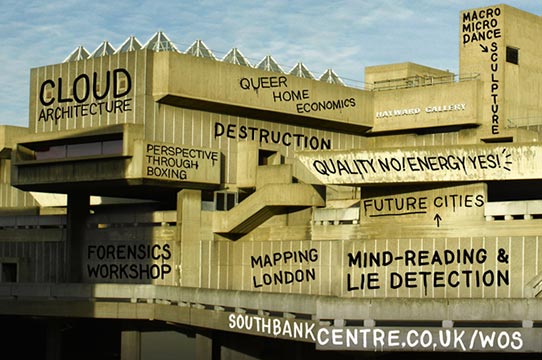
The Hayward Gallery’s Wide Open School is an unusual experiment in learning. Its programme of classes is devised and delivered by over 100 artists from approximately 40 different countries. It is not an art school however. Instead it is a wide-ranging forum where artists lead and facilitate workshops, collaborative projects, collective discussions, lectures and performances about any and all subjects in which they are passionately interested.
That is a territory as expansive as the imaginations of artists, who this summer help to transform Southbank Centre into an international learning site for Festival of the World, showing how art changes lives.
If you peruse the Wide Open School class catalogue, you will encounter a remarkable persity of topics and approaches to learning. It includes material that is under the radar of mainstream culture – things that are overlooked or neglected for one reason or another. It also features classes that involve looking at familiar subjects in a new light. Contemporary artists regularly find fresh ways of approaching research and thinking from other disciplines, from history to physics, from anthropology to economics. Building on these tendencies, Wide Open School exists as a meeting ground for overlapping fields of knowledge. It establishes a temporary haven for lateral thinking.
Yet while they span an eclectic spectrum, the courses in Wide Open School also share a common goal: they offer participants a direct experience of how artists think about and question things. Artists are often great self-educators. Their work demands that they continue to learn, and to invent new ways of learning. They are always looking, and they know that while you may not always find what you are looking for, you can always find a novel way of using what you do find and what you already have. Artists are also experts at embracing contradictions, and knowing how to move forward in understanding a problem without first having to neatly resolve it. It is impossible to ‘teach’ someone how to work like this, except by example and through practice – which is why many of the classes in Wide Open School incorporate some form of ‘active’ learning.
Most schools are in the business of transferring knowledge from teachers to students. Wide Open School, on the other hand, is more like a labyrinth of learning in which various possibilities are explored and developed. As one of the participating artists suggests, it is a school for people who love learning but do not necessarily like schools. It serves up a scenario where people explore subjects for which they share a common curiosity, rather than where ‘students’ are ‘taught’ in any conventional sense. It also provides us with an opportunity for playing with the rules of how we educate ourselves, but it is not a new model for an academy. Playful and serious at the same time, it aims above all to create an energetic atmosphere for formulating and exchanging ideas.
Wide Open School is open to everyone. There are no applications required, no entrance exams to take. Enrolment in classes is on a ‘first come, first served’ basis, except in those instances where an artist has specified their desire to work with particular age groups or inpiduals with special learning needs. While the majority have been invented by artists, a handful of courses are based on proposals from the public. Accommodating different modes of learning, classes range in size from one-on-one conversations to small groups to large gatherings. Several are conducted in languages other than English, depending on languages spoken by the artist leading the class. The broadly international character of the Wide Open School faculty is a significant part of this project, reflecting the historical urgency for us to actively learn from different cultures and different parts of the world.
Wide Open School takes place in classrooms built in the Hayward’s gallery spaces. But it is not an exhibition in any sense, and it demands a very different type of engagement. It asks its participants to make an unusual commitment of time as well as energy. It obliges us to be attentive and open. It invites us to use our intelligence in unusual ways, and to confront our desire to understand and to be understood. It requires a willingness to discuss issues and to make things with strangers. And its success depends on our ability to realize that the contribution of each and every member of the school is significant.
An alternative education from the finest contemporary artists at the Hayward’s Wide Open School
Words by Bryony Quinn, Thursday 24 May 2012 / www.itsnicethat.com
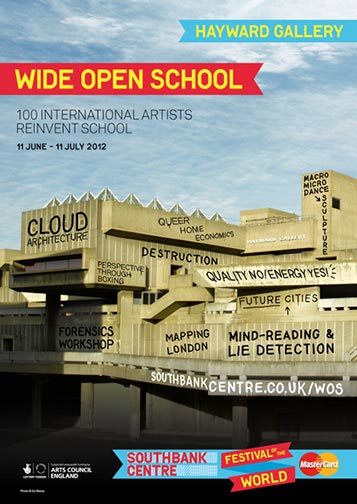
The Wide Open School is just that, an inclusive and experimental programme for public learning. The Hayward Gallery is hosting it as part of the Southbank Centre’s Festival of the World, and they have gathered an estimable faculty of some of the UK’s most contemporary artists – Martin Creed, Tracy Emin, Jeremy Deller, Gillian Wearing, Michael Landy, Bob and Roberta Smith for example – as well as another 94 artists hailing from more than 40 countries.
It is in someway an answer to the question: What would school be like if artists invented education? TWhat could people whose daily lifeblood is the channeling of original thought or unique form or matchless beauty teach us? “That is territory as expansive as the imaginations of artists” the programmers tell us, and so the topics proposed include such disparately delightful subjects as banner-making, boxing as painting, wild-man drawing, the whys of walking, cloud architecture and what we can learn from mountains.
Artists are the “omnivores of culture,” Ralph Rugoff the director of the Hayward Gallery reminds us, and they are used to “teaching themselves what they don’t know how to do” – be it a practical skill or a scientific theory. They are in a special position with a social influence, “experts at contradiction, and knowing how to move forward in understanding a problem without first having to neatly resolve it.” Prime stuff for an alternative education where the outcome is not always more important than the process.
It’s an exciting model, but it is an experiment and a temporary one at that. The lessons that sack off a sermon-like structure in favour of forums or collective discussions or workshops could go on to prove something about arts education in light of the cuts and shaky future of some of our finest institutes, but like everything else that could be taught, positivity is best learnt through example, something these artists have for art in immeasurable loads.
THE ARTIST
Bob and Roberta Smith
(b. 1963, London, UK)
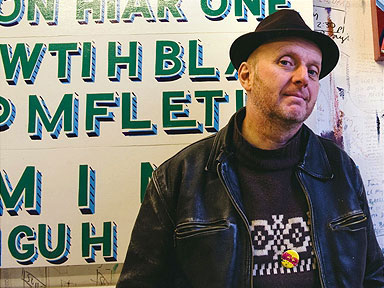
Bob and Roberta Smith (one artist with two names) is an activist who believes that people should make their own art. Over the past 15 years he has produced vibrantly coloured signs and paintings, presenting political sloganeering and absurdist wordplay in a font he calls 'Sign Writers Block'. Bob and Roberta Smith's work also includes performance, music and cookery. Explaining that many of his projects have entailed working with the public rather than producing things for them, he says: 'I'm more interested in how people understand their surroundings, where they are and what they can do; how art can improve their lives and be a language for understanding the world.' A passionate supporter of public spaces and institutions such as museums, galleries and libraries, he sees government cuts to the arts and humanities, and in health and higher education, as 'like ripping up the Magna Carta.'
Among his many other activities, he co-founded the ever inventive Apathy Band, hosts 'Make Your own Damn Music' on Resonance FM and is a Tate Trustee.
Author and journalist Anna Minton has written a series of reports on the urban environment and public spaces in cities. She has investigated the phenomena of gated communities and ghettos in America and their emergence in the UK, and inquired into the growing privatisation of public space in Britain. Her influential book, Ground Control: Fear and Happiness in the Twenty-First Century City, first published is 2009, will be republished on 26 June 2012, with new material including a chapter on the true Olympic legacy.
THE CLASS
Just what is it that makes today's Public Spaces so different, so appealing proposal intervention invitation
Join Bob and Roberta Smith in devising interventions and ways of remodelling London's Public spaces.
The artist will invite discussion, examination and dialogue about what makes a lively and interesting artistic intervention in public space. Participants will then envisage what they want their public intervention to look like and then create proposals based on these ideas, taking the form of a letter or 'parcel of love' to a politician. The artist states that "all proposals and drawings will be forwarded to the Prime Minister's office."
This is the second of three separate events for Wide Open School undertaken by Bob and Roberta Smith, the others are on Monday 11 and Sunday 17 June.
DETAILS :
Price: £10
Concessions: 50% off (limited availability)
Venue: Hayward Gallery Lecture Theatre
Approximate duration: three hours
THE ARTIST
Fritz Haeg
(b. 1969, Minnesota, USA)
Artist, architect, visionary designer and urban gardener Fritz Haeg believes that 'we are obsessed with our homes as protective bubbles from the realities around us', and aims to subvert this state of affairs.
His work has included edible landscapes, public dances, educational environments, domestic gatherings, city parades, temporary encampments and occasionally buildings for people - though he prefers making architecture for animals. His Animal Estates project creates model homes for animals that are unwelcome or have been displaced by humans. Another of his recent projects is Sundown Schoolhouse, a peripatetic educational programme involving happenings, gatherings and ecological iniatives, with workshops, classes, clinics and seminars held in a mobile geodesic tent. Talking about his work, which develops according to his instincts, or what he feels needs to happen, Haeg says: 'I think of it as Trojan Horse art, where it is wheeled out and invades the culture without people being aware of where it came from.'
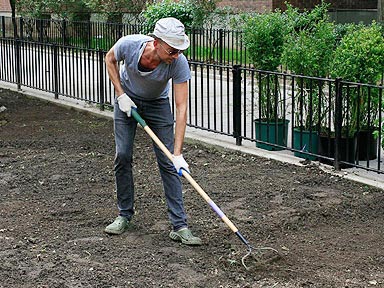
THE CLASS
Sundown Schoolhouse of Queer Home Economics
Fritz Haeg will organise and lead a drop-in centre for classes, demonstrations, seminars, talks, and workshops related to GLBT homemaking, inspired by the program of 'home economics' developed in the 19th century to educate young women in domestic duties.
Fritz Haeg will organise and lead a drop-in centre for classes, demonstrations, seminars, talks, and workshops related to GLBT homemaking, inspired by the program of ‘home economics’ developed in the 19th century to educate young women in domestic duties. The Schoolhouse will take place within and around a geodesic dome installed on the Hayward Gallery’s Western sculpture terrace.
The series will start on 11th June with an introductory talk by Fritz Haeg, Out and In the Homosexual Home, about queer domestic architecture and interiors, also introducing his new project series, Domestic Integrity Fields, of which a London edition will be produced in the Schoolhouse with local collaborators during the program. Haeg will remain in residence for the entire first week (11 - 17 June).
Book in advance for this event and receive 25% off your tickets
Simply add FRITZ to the ‘Offer Code’ box under the ‘Book Tickets’ icon above, or quote FRITZ when buying your ticket over the phone or in person at any Southbank Centre Ticket Office. This offer is valid until midnight on Sunday 10 June.
Below is a schedule for Monday 11 June which gives you an example of what to expect (each day has a varying timetable)
Monday 11 June
10am – 11.30am: Morning movement – open yoga session
11.30am – 1pm: Domestic Integrity Fields with Fritz Haeg – bring your old clothes, fabrics, linens, towels, etc. to crochet into an expanding rug for the space while we sit in a circle and discuss whatever is on our minds.
1pm - 2pm: Lunchtime (bring your lunch)
2pm – 6.30pm: Afternoon sessions and activities
7pm - 8.30pm: Opening Gathering – Out and In the Homosexual Home with Fritz Haeg – Queering Everyday Space in London – Domesticity and Sexual Identity with Brent Pilkey plus potluck dinner
DETAILS :
Price: £10 per day
Concessions: 50% off (limited availability)
Venue: Hayward Gallery: The Sundown Schoolhouse of Queer Home Economics
THE ARTIST
Bedwyr Williams
(b.1967, Newcastle upon Tyne, UK)

Bedwyr Williams is a Welsh artist based in Wales, whose live performances and installations deal with Welshness, otherness and difference. ‘Welsh people are born on the back foot, but as a result of having a second language we’re able to look at the world in a slightly different way,’ he remarks. ‘That’s what my work’s all about, really – it’s how I view the world from my place on the periphery.’ Often described as a stand-up comedian, Williams refutes this claim, explaining that ‘what I do is funny, but there aren’t any jokes as such.’ His work has included the Blaenau Vista Social Club, a travelling night-club in the back of a caravan, and performances featuring a Celtic bard and a ranting, fire-and-brimstone preacher. Williams won the Gold Medal for Fine Art at the National Eisteddfod in Wrexham in 2011 and will represent Wales at the 2013 Venice Biennale.
THE CLASS
The Truth Against The World
Bedwyr Williams gives a lecture-performance he describes as 'a kind of gumball rally through Welsh culture' in which the audience is invited to dress as makeshift Druids with costumes provided in the gallery.
Zig-zagging through Welsh visual culture, participants are led on a tour through Welsh nationalism, subcultures and fashion via the motley figures of Evelyn Waugh, young farmers, the Beatles, the Maharishi, Brian Epstein and Mario Merz.
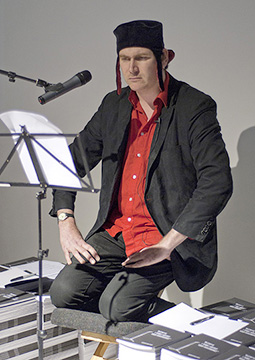
DETAILS :
Price: £10
Concessions: 50% off (limited availability)
Venue: Hayward Gallery Lecture Theatre
Approximate duration: 90 minutes
THE ARTIST
Jane and Louise Wilson
(b.1967, Newcastle upon Tyne, UK)

Jane and Louise Wilson describe their way of looking as 'forensic'. Over the past two decades, their film and video installations have probed collective fears and paranoia, and investigated architectural sites that were former centres of power during the Cold War. Their atmospheric photographs also have a filmic quality, conjuring up underlying narratives of violence or crime. Fascinated by the techniques and politics of surveillance, they have infiltrated and surveyed such locations as the disused US Air Force missile base at Greenham Common, the abandoned headquarters of the East German secret police, and Russia's defunct cosmonaut training centre.
Their recent work has included a photographic portrait of the aftermath of the Chernobyl nuclear disaster and a two-part film installation inspired by the assassination of Hamas official Mahmoud al-Mabhouh in a hotel in Dubai. Entitled Face Scripting: What Did the Building See? , this was commissioned by Sharjah Art Foundation and first presented at the Sharjah Biennial 10 in 2011.
Caroline Wilkinson is Professor of Craniofacial Identification at the University of Dundee. Her research focuses on the development of accurate facial reconstruction methods by analysing the relationships between the soft and hard tissues of the face, in order to assess old and create new standards for practical use.
THE CLASS
In conversation with Caroline Wilkinson
Jane and Louise Wilson in conversation with Caroline Wilkinson Jane and Louise Wilson join Caroline Wilkinson, Professor of Craniofacial Identification at the University of Dundee, in a conversation about the forensic sciences and forensic tendencies in art.
THE CLASS
In conversation with Brian Dillon
Artists Jane and Louise Wilson talk to writer and critic Brian Dillon about the concept of the ruin and its representation in contemporary cultural discourses.
This is the first of two 'Frieze Magazine at Wide Open School' events.
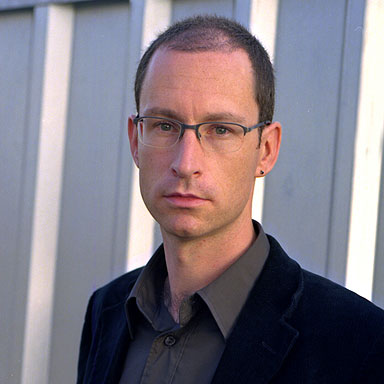
Brain Dillon
DETAILS :
Price: £10
Concessions: 50% off (limited availability)
Venue: Hayward Gallery Lecture Theatre
Approximate duration: 90 minutes
THE ARTIST
Lee Bul
(b.1964, Yongwol, South Korea)
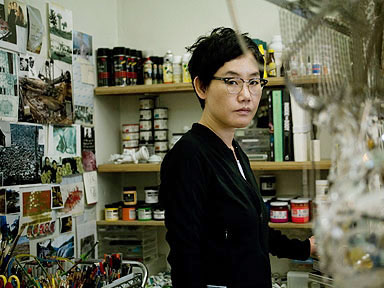
Featuring cyborgs and monsters and futuristic cityscapes, Lee Bul's work explores dreams, ideals and utopias inspired by Japanese anime and manga, bioengineering, and visionary architecture. Her intricate sculptural installations combine new media and innovative technologies in what she describes as a 'dream language that mediates between the unconscious and lived experience.' From her earliest street performances, when she made and wore fantastic 'soft sculpture' costumes, alive with multiple protrusions and dangling viscera, Lee's work has touched on feminist issues. She often questions women's place in society, especially in Korea and Asia, and addresses the ways in which popular culture influences opinions of feminine beauty, both in the East and in the West. Later sculptures have analysed the relationship between woman and machine, producing aberrant hybrids that she calls 'anagrammatical morphologies', while the forms of Live Forever, a trio of fully functional karaoke pods, morph between prototypical racing cars and cryogenic chambers. In these works, Lee explains that her concern is with ideas about 'transcending the flesh and the desire for immortality.'
THE CLASS
From Me, Belongs to You Only
This illustrated lecture takes its title from a line in a love letter sent to Lee Bul. Wanting to share this feeling of intimacy and warmth, she used it as the title of her recent exhibition at the Mori Art Museum in Tokyo. In this lecture, she presents her working processes and all her major projects as shown in that exhibition. This lecture is given in Korean with consecutive English translation.
DETAILS :
Price: £10
Concessions: 50% off (limited availability)
Venue: Hayward Gallery Lecture Theatre
Approximate duration: 90 minutes
THE ARTIST
Dorothy Cross with Philip Hoare
(b.1956, Cork, Ireland)
Dorothy Cross’s sculpture and installations often make associations between found and constructed objects, resulting in playful, challenging, and at times subversive works which are both witty and poetic. In her early work she used and transformed a range of natural materials, such as cows’ udders and hides, snake skins and taxidermy birds, to explore issues related to desire, as well as cultural and political conventions. In a collaboration with her scientist brother Tom Cross in 2002, she produced Medusae, a film about jellyfish. More recently, her work has focused on time, memory and man’s place in relation to the natural world, as in Stalactite, a video of a boy soprano singing below a massive stalactite in the west of Ireland. In Finger Tip Pearl she placed the fingertip bones of a human hand into five black-lipped oysters in a lagoon in Tahiti; around one of them a pearl was formed.
Philip Hoare has had a lifelong obsession with whales. His prize-winning book, Leviathan or, The Whale (first published in 2008), takes us deep into the whale’s domain, showing these mysterious and little-understood creatures as they have never been seen before.
THE CLASS
Jellyfish into Whales: Art, Narrative, and the Deep
Dorothy Cross addresses the challenge of portraying the 'human' in relationship to 'nature' and the animal world through her practice, which has ranged from working with jellyfish to whales, shark-callers and snakes, subtly transforming her materials with strange and poetic results.
Philip Hoare, author of 'Leviathan or, The Whale', discusses his own extensive relationship with whales in the wild, and looks at the whale in art and fiction, from Captain Ahab's obsession with the mythical 'Moby Dick', to the way the modern world sees whales and the oceans within which they swim.
DETAILS :Price: £10
Concessions: 50% off (limited availability)
Venue: Hayward Gallery Room 2
Duration: 90 minutes
THE ARTIST
Christine & Jennifer Binnie & Wilma Johnson
22 JUNE
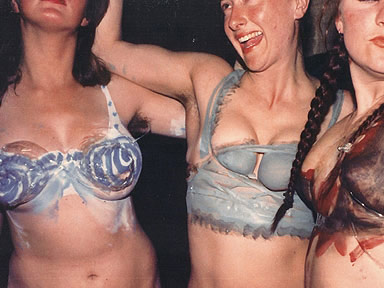
Neo Naturism is a performance based live art practice started by Christine Binnie, Jennifer Binnie, and Wilma Johnson in London in 1980. The group was founded in the cultural context of post punk, the New Romantics, Rolf Harris, transvestites, the advent of Thatcherism and the London club scene. An anarchic exploration of everyday and ritual actions, 'common sense' and nudity, and a celebration of their bodies as paintings, the Neo Naturists performed naked wearing body paint in clubs, galleries, festivals and site-specific performances. They resolved to become 'Neo Naturist Octogenarians', keeping their practice going until they reached their 80s but their activities as a group now happen at a much slower pace.
Since 2006 they have been compiling the Neo Naturist Archive which has been exhibited at galleries including the ICA, London and the Munich Kunstverein.
THE CLASS
Neo Naturist Life Class
For this class, Christine and Jennifer Binnie and Wilma Johnson run a life drawing class where the role of tutor, model and canvas are interchangeable. The result will be a performative soup of participation, paint, art and ritual. Formerly known on the club and art scenes of the 1980s as the Neo Naturists, the Binnies and Wilma Johnson reunite for the first time since 1987.
DETAILS :Prices:
£10
Concessions:
50% off (limited availability)
Venue: Hayward Gallery Room 2
Activities will be held in three phases and participants are free to join for one, two or all three. Please arrive in time for the start of each phase:
10am to 12.30pm
Phase One - morning exercises
2.30pm to 5pm
Phase Two - for Tea Time
6pm to 7pm
Phase Three - Party wear! (Body painting only)
All participants are required to be either completely nude or to attend barefoot. Please bring a towel.
Strictly over 18s only.
THE ARTIST
Cesare Pietroiusti
(b. 1955, Rome, Italy)
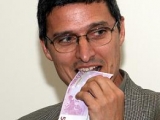
Cesare Pietroiusti's interventions, performances and video works are primarily concerned with questioning our ideas of value in terms of both money and art, and rethinking the logic of exchange. Reversing our usual relationship with money, he has opened a shop where the goods for sale are banknotes and the currency used to purchase them is the customer's gaze, and set up exhibitions where the artworks are exchanged for visitors' ideas.
Pietroiusti's practice often starts with assigning himself or others a task, or asking others to give him instructions. He has solicited stories from people in the street (and elsewhere) and bartered with practical skills, giving lessons in making mayonnaise, writing the Greek alphabet or properly flossing one's teeth in exchange for being taught to cut hair, use Photoshop, or remove one's vest without taking off one's coat. His interests lie in collaboration, participation and co-authorship: 'what I like most is that popping up of ideas that wouldn't have otherwise emerged from the individual minds of the participants.'
THE CLASS
Production and Free Distribution of Drawings Workshop
A whole day workshop in two parts, the outcome of which is that drawings created by the artist and participants are then given away for free but subject to various specific conditions - for example, the owner or 'holder' of the drawing commits to give it away to the first person who asks them a question that they cannot answer.
Each whole day workshop is in two parts. Mornings are spent brainstorming to arrive at the particular conditions to be printed on these transient gifts, which are intended to be passed from one temporary holder to the next. Afternoons are occupied with the actual making of the drawings, using unconventional media such as tea, salt water or beer.
DETAILS :
Price: £10 per day
Concessions: 50% off (limited availability)
Venue: Hayward Gallery Room 4 (19 and 20 June), Hayward Gallery Room 1 (21 and 22 June)
Approximate duration: 7.5 hours including a two-hour break
VISITOR INFO

HOW TO BOOK
ONLINE
southbankcentre.co.uk/wos
(£1.75 transaction fee*)
PHONE
0844 847 9910
9am – 8pm daily
(£2.75 transaction fee*)
IN PERSON
Southbank Centre Ticket Desks
Hayward Gallery 10am – 6pm daily (no transaction fee)
* No transaction fee for Southbank Centre Members
and Circles Supporters
CONCESSIONS
Limited number of half-price tickets and day
passes available.
Visitsouthbankcentre.co.uk/concessions
TRANSPORT AND ACCESS
ACCESS
Southbank Centre is accessible to
people with disabilities.
Email: accesslist@southbankcentre.co.uk
Phone: 0844 847 9910
Fax: 020 7921 0607
PUBLIC TRANSPORT
Southbank Centre is located on the
Thames riverside between Golden Jubilee
and Waterloo Bridges.
Underground: Waterloo & Embankment
Buses: Waterloo Bridge, York Road,
Belvedere Road & Stamford Street
National Rail: Waterloo, Waterloo East
& Charing Cross
